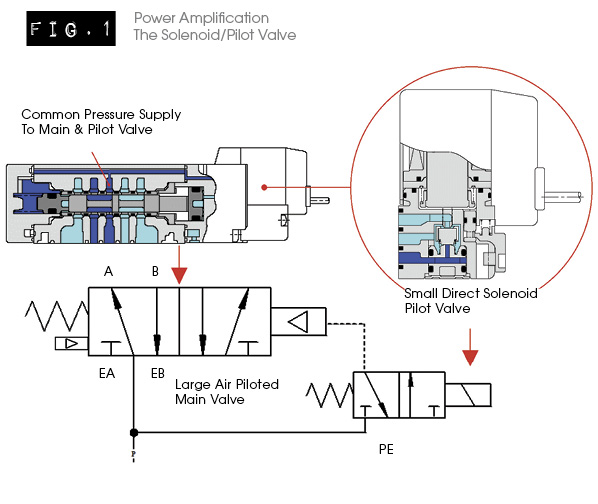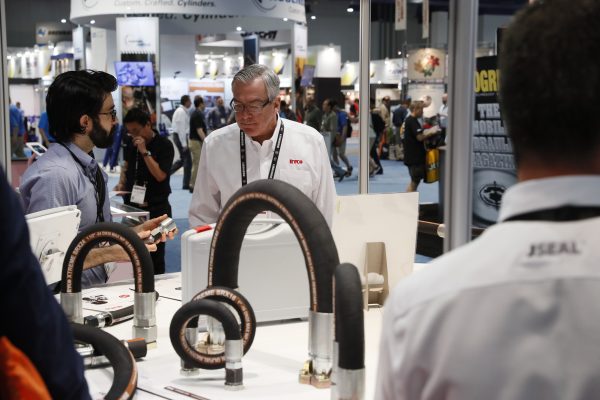How Much Coal Does That Valve Burn?
Richard F. Bullers
Back when gasoline was 35 cents a gallon, the term “environmental technology” was not well known. Engineers did not often promote the benefits of building low-energy consumption pneumatic valves among their peers. Recycling or conservation of resources was seldom discussed with any seriousness. In reality, the conversation was more likely to have turned to the muscle cars of the day and how much horsepower they would generate.
This “bigger-is-better” philosophy not only produced big block engines with three carburetors, but also pneumatic valves with large direct solenoids and bulky steel construction. Then one day some of us woke up to find out the meaning of an Arab Oil Embargo. Suddenly the thought that our energy supply was cheap, plentiful, and secure evaporated.
A typical pneumatic solenoid valve of that era may have consumed 6 Watts of power and lasted 10 million cycles. Today a pneumatic valve can be operated with power consumption as low as 0.1 Watt with a life of over 200 million cycles. This is an amazing 60 times less energy with 20 times the life. How is this now possible?
The Transition to Modern Valve Design
One technique that dramatically lowered the energy consumption of a pneumatic valve was using the concept of flow amplification. A very small 3-port, 2-position, direct-solenoid valve is used to operate a much larger air-operated valve. The small solenoid results in low power consumption (Fig. 1).

At the heart of this transformation is the development of advanced design direct solenoid valves that are diminutive in both size and power consumption.
The solenoid pilot valves have also undergone specific design changes to improve their performance and use less energy. As valve design evolved, materials changed from zinc die cast to anodized aluminum, to engineering plastics. This has resulted in valves with streamlined shapes and lower mass. The internal passages, spool and sleeves, and poppet designs changed to increase flow capacity.
The advent of serial communications systems that use coded signals to operate individual solenoids on banks of valves mounted together on a common manifold has eliminated cumbersome wiring harnesses and improved electrical efficiency. Now entire networks of valves can be controlled, monitored, and programmed from a remote location.
As industrial automation produces ever more sophisticated machines with the advance of robotics, benefits of weight reduction and power conservation in pneumatic valve design are beginning to find their role in a larger strategy of environmental technology.
Optimizing solenoid valve design may seem a trifle affair when compared to reducing gasoline consumption for an automobile, but every unnecessary ounce of material and unit of energy expended have a collective and negative impact. The vast majority of energy used to manufacture and operate virtually every modern object we use every day is electricity generated from coal.
The Transferable Benefits of Energy Conservation
There are over 600 coal-fired electricity plants operating in the United States today. A typical 500-megawatt coal plant will discharge 10,000 tons of sulfur dioxide; 10,200 tons of nitrogen oxide; 720 tons of carbon monoxide; 125, 000 tons of ash; and 3,700,000 tons of carbon dioxide in addition to tons of other disagreeable waste products.1
We don’t need an alarmist to remind us we do not want ourselves or our children breathing pollution, but this issue is often as invisible as the air. It’s not just asking about what we can change over the next decade, but how our very next decision in regards to purchasing and applying pneumatic valves can work to both our immediate and long term advantage.
The long-term benefits of reducing energy consumption are the short-term rewards that can be realized by machine builders, maintenance personnel, plant managers, or anyone applying pneumatic valves. The most immediate profit for end users is from a reduction in electricity consumption, but for everyone there is a strategic advantage gained from the “transferable benefit” created.
Transferable benefits are gains you make that can be passed along to your customers, shareholders, employees, or anyone in general. It is a reduced cost, a “green machine,” a reputation as an environmentally conscious company that can boost a bottom line, beat a competitor machine’s operating costs, or gain business from public awareness. Imagine competing on a reduction in operating costs by positioning yourself as an energy-efficiency leader in your industry.
In conclusion you might wonder; how much coal does that valve burn? Twenty times, thirty times, sixty times more then it needs to? Look at the valves you have in service, compare your energy costs, and explore your alternatives. An epiphany can not only be enlightening, but also profitable.
Practical Techniques for Energy Savings
How can cost savings from the application of pneumatic valves be achieved?
1.Apply energy-efficient pneumatic valves whenever possible.
Where previously a valve may have used 6 Watts to operate, the same valve now could be operated for a 10th of a Watt. This is an amazing 60 times less energy use. Not all applications can reduce their energy consumption by this amount, however significant gains can be made with a modest amount of effort.
The replacement of old energy-inefficient pneumatic valves can be done as part of a major overhaul or simply as a replace-as-needed strategy. This also provides several opportunities. One is to check the valve to ensure it is not oversized. Another is to conduct an energy audit.
Energy audits are an effective tool in identifying waste and making a plan for corrective action. According to Hank van Ormer, Air Power USA, Inc., “Compressed air conservation and optimization programs in any compressed air system will generate significant energy savings opportunities, plus probable improvement in productivity and quality.”2
You’ve been changing to energy-efficient light bulbs in your house, so why wouldn’t you change the same old valves you’ve been using all these years? Check the power consumption of any valve product you have in service and ask if there is another way of doing the same job with less energy. When purchasing a valve, ensure the flow capacity and valve function are correct and make it a “trifecta” by getting the lowest wattage valve possible.
2.Shop for energy-efficient machines.
What do you do when you buy a water heater, stove, refrigerator, air conditioner, furnace, or virtually any other appliance? You look at the Energy Star3 rating, of course. Ask the machine builder to explain what the power consumption of their machine is and how their product was designed with energy savings in mind.
If you are contracting with a machine builder, make low power consumption one of the stated design goals. Ask them for a return on investment analysis for operating costs versus machine purchase price. This will provide incentives for manufacturing a machine that will pay for itself in a reasonable amount of time and help you determine if the price is right.
3.Build energy-efficient machines.
For a machine build, this sounds like a naïve statement, but in reality it is simply a matter of using a straightforward approach, technical challenges notwithstanding. The lines are not always clearly drawn between practicality, manufacturing costs, or competitive advantage, however there are basic techniques that can be applied.
The amount of motive power necessary to do any task can be greatly reduced by the use of gears, levers, springs, and other practical mechanical devices that reduce the force required to achieve the work required.
A low-power valve can be used to operate a larger air-operated valve to advantage in many applications.
- For 2-port and 3-port valves, use Normally Open types when seldom actuated to the off position and Normally Closed types for opposite scenarios.
- For 4-port and 5-port valves, consider the use of a 2-position double solenoid valve when long periods of air output are required. This type of valve only requires a momentary signal to shift and can remain for very long periods of time in an actuated position.
- A “UPS” system (uninterrupted power supply) may be a better alternative as part of a redundant safety system than relying on the interruption of continuous power supplied to a solenoid valve to initiate a stop sequence.
4.Use the correct amount of air pressure.
Pressure is energy and energy is money. Using more energy than required for a single actuator adds up over time. Producing more pressure in a plant than is necessary multiples the effect.
- Consider “check type” regulators or using a check valve in parallel with a standard regulator to reduce pressure for the non-working stroke of an actuator that only requires high force in one direction.
- Check load ratios and actuator sizing carefully to reduce unnecessary consumption.
- Reduce the volume between directional control valves and actuators to eliminate waste and improve response time and control.
- Reduce the compressed air pressure for the entire plant if only one or two applications are running at a higher pressure by using air intensifiers at point of use.
5. Avoid the use of “air blow” applications. When air blow is required, use efficient nozzle designs with minimum operating times and careful sizing techniques.
6. Use the “OFF” switch.
If the machine is not is use for a shift, a day, or a week, why supply pneumatic energy to it? Use a shut-off valve with a tight leakage specification to conserve energy.







